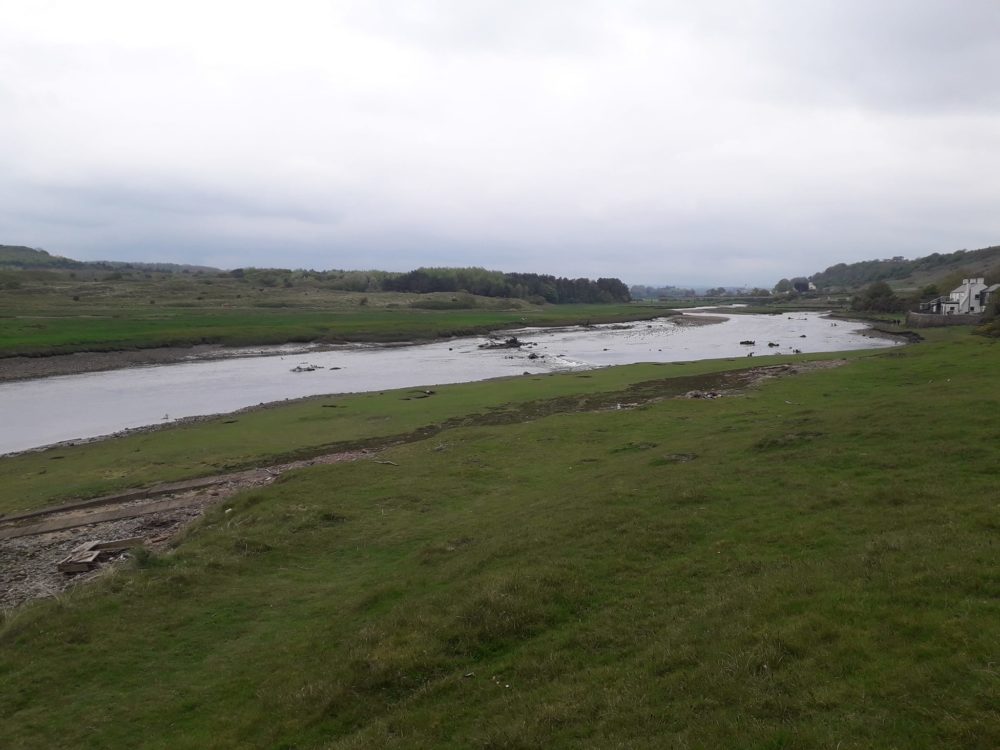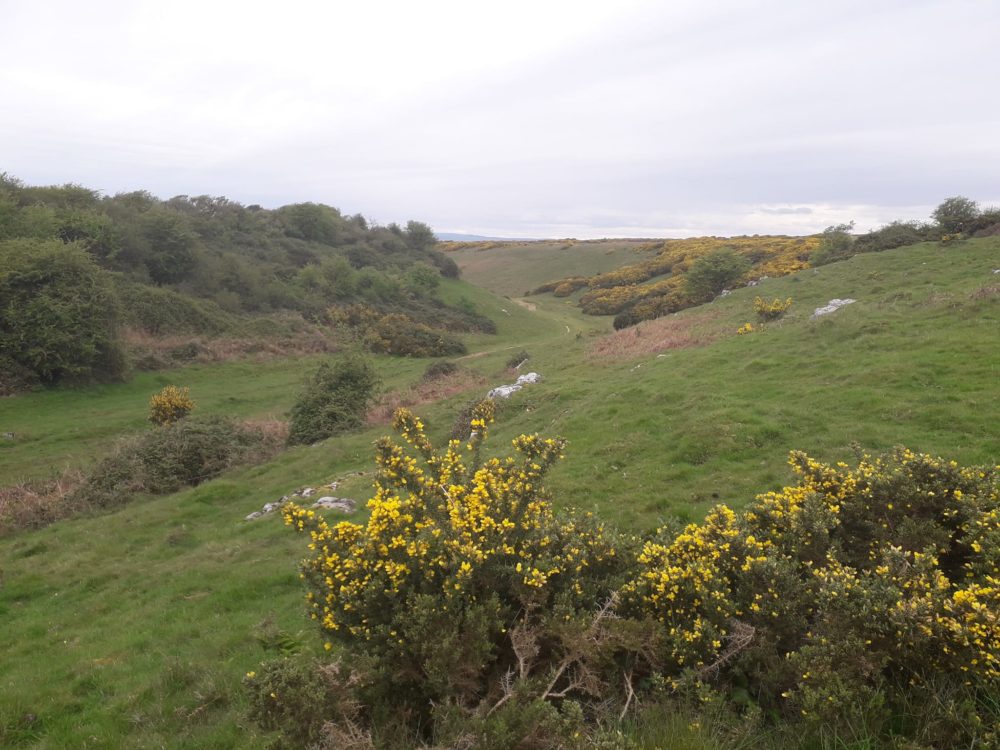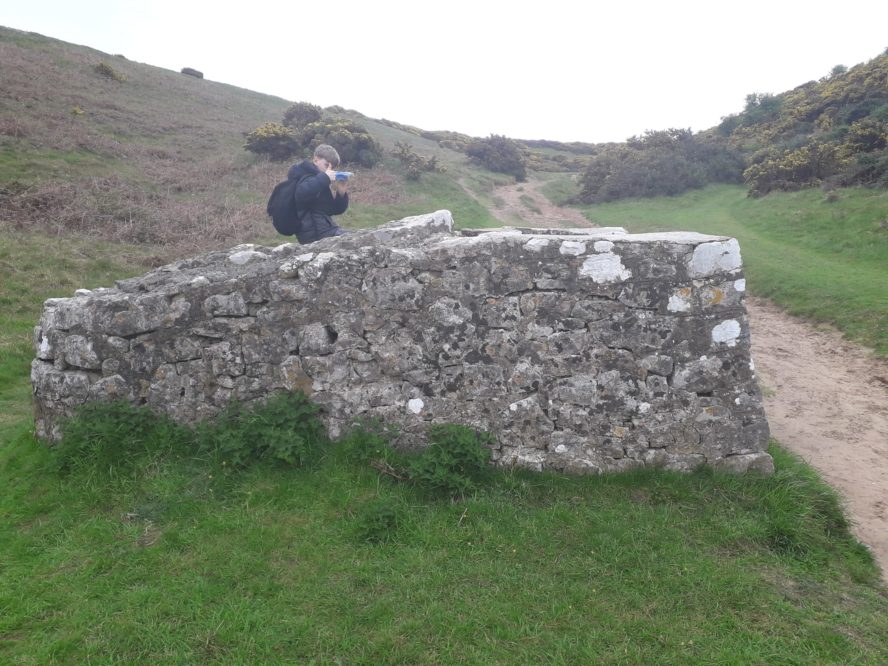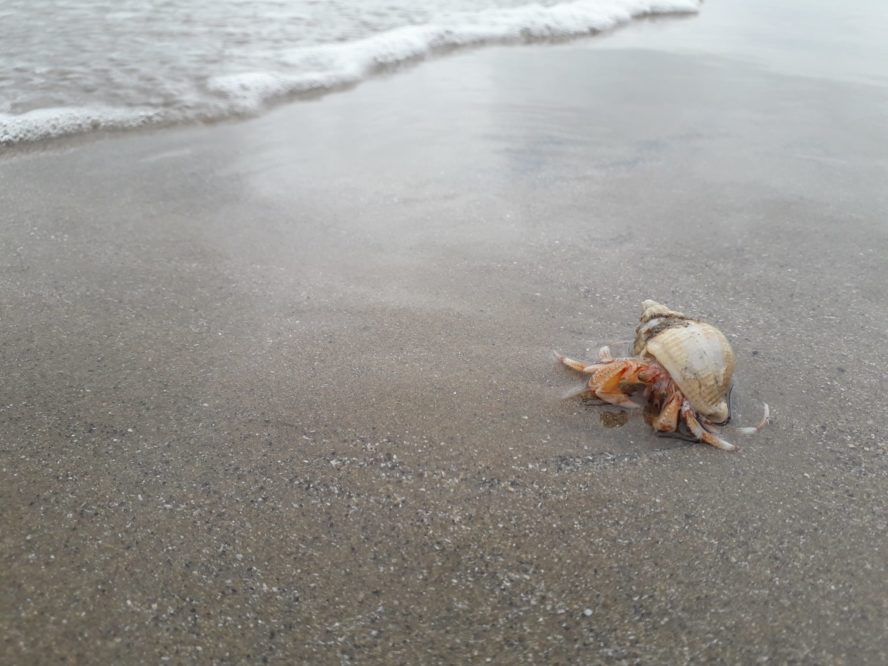A circular walk with a Duchy Original

Ken Moon
April this year continued the weather theme of the previous few months, being unsettled, wet and unremittingly dull. After a warm start temperatures dropped again, leaving us all feeling cold and damp into early May.
Thankfully, by the time the May Bank holiday half term holiday arrived the grey clouds were slowly beginning to lift a little and I started to mull over the idea of an achievable walk to celebrate.
Growing up in Cardiff I’d often visited Ogmore by Sea, more commonly referred to simply as Ogmore, for a fun day swimming in sewage laden seas and challenging each other to swim against the strong current of the equally sewage laden ‘swift surge’ of the Afon Ogwr, before building sandcastles and enjoying a picnic (without first washing our hands) followed by ice-cream, before heading home shattered but content.
Ah, simpler times.
Our own children too had had similar experiences of the beach at Aberogwr when they were younger, albiet once they’d discovered the delights of Barry Island our simpler, often cold and windswept visits, dwindled into memory.
Pant y Cwteri
Like many visitors before me though I’d long held a desire to park up well short of the beach and explore the intriguing prospect of Pant y Cwteri, the hollow valley that intersects the Ogmore road.
I’d persuaded the family to stop there once before. Parking at Portobello House we’d enjoyed a walk along the banks of the Ogwr to the beach. But I’d never quite managed to persuade anyone else to join me for a walk along the Pant y Cwteri, a dry glacial valley carved out during the last ice age which skirts the southern edge of ‘Ogmore Down’, today home to ‘Southerndown Golf Club’.

On this May half term day, whilst studying my trusty OS Map for a circular route, I found an unusually willing companion for the day in my son. It seems that his friends are late risers.
With the car-park at Portobello House closed we found a suitable looking grassy verge and set off to explore the Ogmore to Southdern Down Circular, an gratifying mornings walk through thousands of years of Hanes Cymru.
Following in the hoofprints of ancient pastoral farmers we walked the dry glacial valley, admiring the rough pasture of the landscape, until we came to fork in the ddyffryn. Here the right-hand fork climbs steadily following the Pant Norton towards the hamlet of Norton and the ridgeway road. Whilst this promised to reward us with excellent views down to the coast, our immediate interest was drawn towards an unusual structure.
Stone cowling
Placed incongruously in the middle of the valley sites the stone cowling for a well. We took a closer look.
Stepping through the opening we descended a short flight of steps to find clear flowing water. The cowling then having been built to protect this freshwater source from being muddied by thirsty livestock. Above us on the ridge stood the remains of a Bwthyn which would once have looked out across the valley.
We learned later that this well may have been sunk by settlers from Flanders to access an underground water course, giving rise to the name Pant Mari Flanders.

Following the seizure of lowland Glamorgan by Robert Fitzhammon settlers from the ‘low countries’ were enticed to settle this part of Cymru in the early 11th century with promises of rich farmland.
They would have come under the jurisdiction and protection of Ogmore Castle and the ‘manor of Ogmore’, gifted to Williams de Londres as a reward for his service in helping to conquer the indigenous people of Morgannwg.
Unhappy with Norman rule the local population rebelled in 1116. William vacated the Castle in haste leaving its defence to his ‘butler’ who successfully held on to the castle, and with it the surrounding lands. The de Londres made generous gifts of land to the church in thanks, but hostilities with the local population rumbled on for decades.
When Williams son founded Ewenny Priory in 1141, it was founded with stout defences.
In 1297 Mary Charworth, the heiress of Thomas de Londres, married Henry the 3rd Earl of Lancaster, and the manor and castle of Ogmore became part of the Duchy of Lancaster. And they remain “…part of the Duchy of Lancaster’s Welsh estate” to this day.
In a recent Channel 4 dispatches documentary The King, The Prince & Their Secret Millions passing reference is made to two nearby quarries.
Mineral rights
The dispatches documentary reveals that the Duchy of Lancaster lease the mineral rights of the Lithalun & Pant limestone quarries near Ewenny in the Vale of Glamorgan to international aggregates giant, and significant carbon emitter, Heidelberg materials. But just how extensive this ‘Welsh Estate’ is, and precisely how much private untaxed income this generates for Charles, the Duchy is incredibly tight-lipped about.
The same weekend that the Dispatches programme aired, the Sunday Times published details of their joint investigation into Duchy land holdings showing how the Duchy of Lancaster earns Charles around £27million a year.
Run as a private business separate from the Crown Estate this once medieval fiefdom is now a commercial operation that is exempt from both capital gains and corporation tax.
What the Duchy of Lancaster website does tell us is that Charles’ private estate holds “…an extensive mineral portfolio extending from South Wales to North Yorkshire. The portfolio consists of limestone and sandstone quarries, which supply material to the UK construction sector”.
But what it does not tell us is, what land is held where, and how these holdings influence the local landscape and public decision making.
The Sunday Times published an online map of Duchy land holdings which reveals around twenty-five land holdings, including those with mineral rights in a wide vicinity of Ogmore Castle. These run from the coast at Ogmore-By-Sea, and include Southerndown Scout Hut, north along the Afon Ewenny all the way past Maesteg, before cutting across to Rhondda Cynon Taff, and then extending eastwards as far as the Gwent levels.
Some of these sites are contested by local communities today.
Duchy holdings
Because the Duchy has refused Parliamentary requests to share information about their holdings then short of putting in further Freedom of Information requests, or travelling to the National Archives in Kew to wade through some of the many ancient charters outlining the extent of Duchy holdings, we are unlikely to ever know all of the rights and privileges Charles now enjoys through his inherited holdings in Cymru.
Leaving the well at Pant Mari Flanders behind us we continued up the valley and came to an area of open common land at Heol Y Mynydd. We anglophones readily accept that Mynydd simply means mountain, but the designation of land as a Mynydd has more to do with the way it’s farmed, than its height above sea level. Which might be why we find this ‘mountain road’ less than 90ft above y mor.
At Heol Y Mor we turned right towards ‘Southern Down’. In English a down is generally used to describe a relatively open undulating chalk or limestone landscape consisting of semi-natural unimproved grassland, with scattered scrubs or trees.
But before this landscape became known as a ‘down’, it may once have been known as a Rhos. We walked along Heol Y Down where we passed a cottage named Bwthyn Rhosyn.

As an open landscape this land may once have been held in common between local livestock farmers, in a similar way to uplands further in-land. It’s thought that the now threatened bio-diverse landscape known as Rhos once covered as much as 40% of Cymru. During the eighteenth century, facing the pressures of a growing population, many people took to squatting the Rhos, rather than taking to the roads.
Enclosures in Cymru led by y Cymry, rather than wealthy landlords.
We followed Heol Y Down to the horse stables at Groes Farm where I was granted the right to relieve myself in an outhouse with a fine view of the coast. From the ridgeway road we took a verdant green lane buzzing with insects and bird life before crossing the main coast road where we opted for a much-needed rest stop on the cliffs at West Farm.
From this lofty vantage point, we were able to sit and enjoy magnificent views along the cliffs, towards ‘Southern Down’ in one direction, and ‘Ogmore-by-Sea’ to the other.
Repast complete we followed the coastal path along the cliff tops, and down to join the shore at Bwch y Gro where I fell in love again with the sheer variety of delights that there are to savour along this stretch of coastline.

After our long walk we were too tired too tired take our planned for a swim, but we spied Hermit crabs, coming ashore in great numbers to breed among the waves where the fishermen cast their lines.
When I asked the usual ‘caught anything?’ the fisherman replied ‘Only dog fish today. We throw them back, but they get confused by the incoming tide, and head for shore’. How many survive this he didn’t say.
We walked back along the shore towards ‘Ogmore-by-Sea’, the carpark and an ice-cream before our tired legs carried up back up along the bank of the Ogwr to Portobello House, our car, and our journey home.
Looking back on this walk today I find myself wondering just whose shore we walked along, who owns the land the council run car park is on, and into whose pockets the money we pay for parking and ice-cream goes.
And I wonder how much more there is to know about this Duchy Original.
Support our Nation today
For the price of a cup of coffee a month you can help us create an independent, not-for-profit, national news service for the people of Wales, by the people of Wales.




